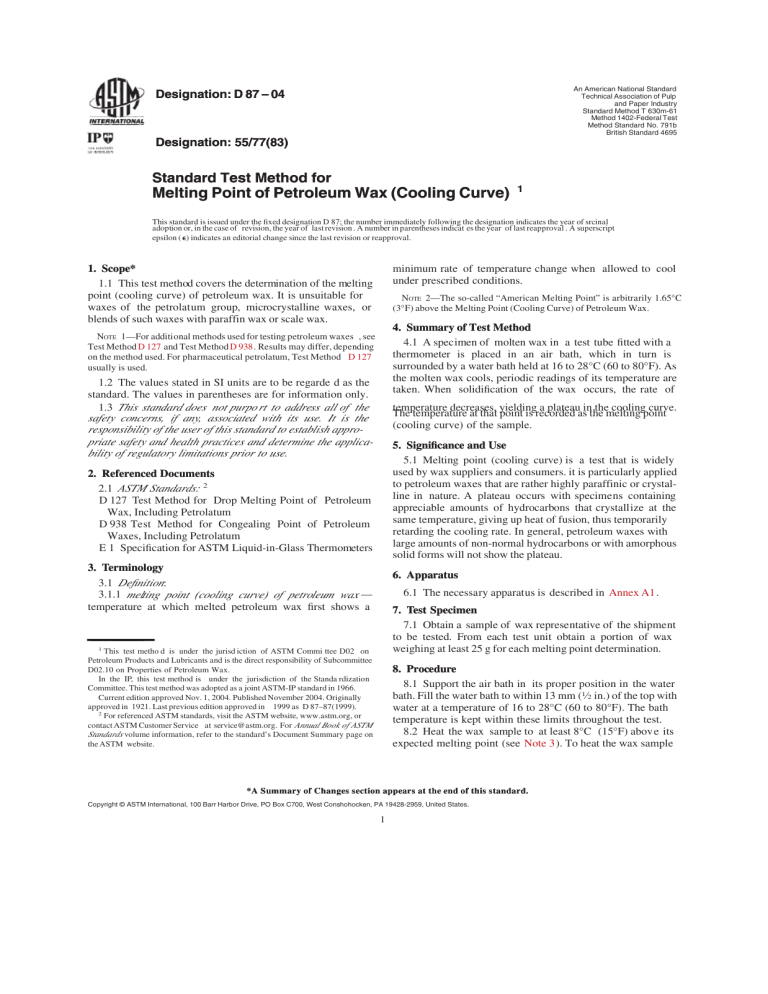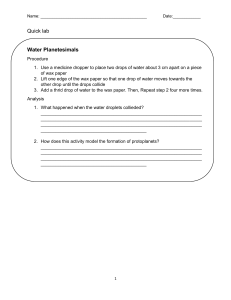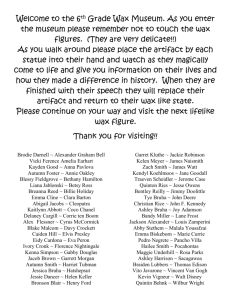
An American National Standard Technical Association of Pulp and Paper Industry Standard Method T 630m-61 Method 1402-Federal Test Method Standard No. 791b British Standard 4695 Designation: D 87 – 04 Designation: 55/77(83) Standard Test Method for Melting Point of Petroleum Wax (Cooling Curve) 1 This standard is issued under the fixed designation D 87; the number immediately following the designation indicates the year of srcinal adoption or, in the case of revision, the year of last revision . A number in parentheses indicat es the year of last reapproval . A superscript epsilon ( e) indicates an editorial change since the last revision or reapproval. minimum rate of temperature change when allowed to cool under prescribed conditions. 1. Scope* 1.1 This test method covers the determination of the melting point (cooling curve) of petroleum wax. It is unsuitable for waxes of the petrolatum group, microcrystalline waxes, or blends of such waxes with paraffin wax or scale wax. NOTE 2—The so-called “American Melting Point” is arbitrarily 1.65°C (3°F) above the Melting Point (Cooling Curve) of Petroleum Wax. 4. Summary of Tes t Method NOTE 1—For additional methods used for testing petroleum waxes , see Test Method D 127 and Test Method D 938. Results may differ, depending on the method used. For pharmaceutical petrolatum, Test Method D 127 usually is used. 4.1 A specimen of molten wax in a test tube fitted with a thermometer is placed in an air bath, which in turn is surrounded by a water bath held at 16 to 28°C (60 to 80°F). As the molten wax cools, periodic readings of its temperature are taken. When solidification of the wax occurs, the rate of 1.2 The values stated in SI units are to be regarde d as the standard. The values in parentheses are for information only. 1.3 This standard does not purpo rt to address all of the safety concerns, if any, associated with its use. It is the responsibility of the user of this standard to establish appropriate safety and health practices and determine the applicability of regulatory limitations prior to use. temperature decreases, yielding a plateau in the cooling curve. The temperature at that point is recorded as the melting point (cooling curve) of the sample. 5. Significance and Use 5.1 Melting point (cooling curve) is a test that is widely used by wax suppliers and consumers. it is particularly applied to petroleum waxes that are rather highly paraffinic or crystalline in nature. A plateau occurs with specimens containing appreciable amounts of hydrocarbons that crystallize at the same temperature, giving up heat of fusion, thus temporarily retarding the cooling rate. In general, petroleum waxes with large amounts of non-normal hydrocarbons or with amorphous solid forms will not show the plateau. 2. Referenced Documents 2.1 ASTM Standards: 2 D 127 Test Method for Drop Melting Point of Petroleum Wax, Including Petrolatum D 938 Test Method for Congealing Point of Petroleum Waxes, Including Petrolatum E 1 Specification for ASTM Liquid-in-Glass Thermometers 3. Terminology 6. Apparatus 3.1 Definition: 3.1.1 melting point (cooling curve) of petroleum wax — temperature at which melted petroleum wax first shows a 6.1 The necessary apparatus is described in Annex A1 . 7. Test Specimen 7.1 Obtain a sample of wax representative of the shipment to be tested. From each test unit obtain a portion of wax weighing at least 25 g for each melting point determination. 1 This test metho d is under the jurisd iction of ASTM Commi ttee D02 on Petroleum Products and Lubricants and is the direct responsibility of Subcommittee D02.10 on Properties of Petroleum Wax. In the IP, this test method is under the jurisdiction of the Standa rdization Committee. This test method was adopted as a joint ASTM-IP standard in 1966. Current edition approved Nov. 1, 2004. Published November 2004. Originally approved in 1921. Last previous edition approved in 1999 as D 87–87(1999). 2 For referenced ASTM standards, visit the ASTM website, www.astm.org, or contact ASTM Customer Service at service@astm.org. For Annual Book of ASTM Standards volume information, refer to the standard’s Document Summary page on the ASTM website. 8. Procedure 8.1 Support the air bath in its proper position in the water bath. Fill the water bath to within 13 mm (1⁄2 in.) of the top with water at a temperature of 16 to 28°C (60 to 80°F). The bath temperature is kept within these limits throughout the test. 8.2 Heat the wax sample to at least 8°C (15°F) abov e its expected melting point (see Note 3). To heat the wax sample *A Summary of Changes section appears at the end of this standard. Copyright © ASTM International, 100 Barr Harbor Drive, PO Box C700, West Conshohocken, PA 19428-2959, United States. 1 D 87 – 04 use a suitable container in an oven or water bath which is held at a temperature not exceeding 93°C (200°F). Avoid the use of direct heat such as flame or hot plate. Do not keep the sample in the molten state longer than 1 h. 9.2 Report the result to the near est 0.05° C (0.1°F) as the Petroleum Wax Melting Point (Cooling Curve), Test Method D 87. NOTE 3—If no estimate of the melting point is available, heat the wax sample to 10°C (15°F) above the temperature at which the wax is completely molten, or to from 90 to 93°C (195 to 200°F) before proceeding to the next step. 10.1 Precision—The precision of this test method as determined by statistical examination of interlaboratory results is as follows: 10. Precision and Bias NOTE 5—This test method is considered suitable for waxes of melting point between 38°C (100°F) and 82°C (180°F). The precision data below were obtained in interlaboratory studies by ASTM Committee D02 using waxes in 127 to 144°F range and by IP using waxes in 108 to 151°F range. 8.3 Fill the test tube to a height of 51 mm (2 in.) with the melted sample. Insert the melting point thermometer through the center of a cork so that the 79-mm (3 1⁄8-in.) immersion line is at the lower surface of the cork. Insert the cork into the test tube so that the bottom of the thermometer bulb is 10 mm ( 3⁄8 in.) from the bottom of the test tube. Support the test tube assembly in the air bath, as shown in Fig. A1.1 , while the temperature of the molten wax is still at least 8°C (15°F) above its expected melting point ( Note 3). 10.1.1 Repeatability—The difference between two test results, obtained by the same operator with the same apparatus under constant operating conditions on identical test material, would in the long run, in the normal and correct operation of the test method, exceed the following values only in one case in twenty: 0.1°C (0.2°F) 10.1.2 Reproducibility—The difference between two single and independent results obtained by different operators working in different laboratories on identical test material would, in the long run, in the normal and correct operation of the test method, exceed the following value s only in one case in twenty: 8.4 Read the melting point thermo meter every 15 s. Record each reading to the nearest estimated 0.05°C (0.1°F). Observe the progress of these sequential readings to determine the appearance of the plateau. Identify the plateau as the first five consecutive readings all of which agree within 0.1°C (0.2°F). Discontinue the test after obtaining these five plateau readings. 0.5°C (1.0°F) 10.2 These precision values have been obtained by statistical examination of interlaboratory test results and were first published in 1965. These values are based on a study among 15 laboratories, using five paraffin waxes with a melting point range of 53 to 66°C (128 to 151°F). 10.3 Bias—The procedure in this test method has no bias because the value of melting point can be defined only in terms of a test method. NOTE 4—If no plateau as definedreached above, the reading procedure is continued until either ( 1appears ) the temperature 38°C (100°F) or ( 2) the temperature reaches a point 8°C (15°F) below a temperature where the wax has solidified (as may be observed through a transparent bath). In either of these cases the test is discontinued and the method is judged Not Applicable to the sample (see Note 1 for other methods). 9. Calculation and Report 9.1 Average the first five consecutive thermometer readings of the identified plateau, which agree within 0.1°C (0.2°F). Correct this average for error in the thermometer scale where necessary. 11. Keywords 11.1 cooling curve; melting point; petro leum wax; wax ANNEX (Mandatory Information) A1. APPARATUS A1.1 Test Tube —A standard glass test tube, 25 mm (1 in.) in outside diameter, and 100 mm (4 in.) in length. It may be marked with a reference line for sample filling at 51 mm (2 in.) above the bottom, and a reference line for positioning of the bottom of the thermometer at 10 mm (3⁄8 in.) above the bottom. (51⁄8 in.) in insid e diameter and 152 mm (6 in.) in depth . Provide a fitted cover equipped to support the air bath vertically so that the side s and bott om of the air bath are surrounded by a layer of water 38 mm (1 1⁄2 in.) thick. Provide the cover with an opening through which the bath thermometer may be suspended 19 mm ( 3⁄4 in.) from the outside wall of the water bath. A1.2 Air Bath —A cylinder 51 mm (2 in.) in inside diameter and 114 mm (4 1⁄2 in.) in depth, equipped to hold the test tube firmly in a vertical position in the center of the air bath. As examples, a tight-fitting cork having a central opening or a metal plate top with a spring clamp that holds the test tube NOTE A1.1—The air bath, water bath, and water bath cover may be made in one assembly as shown in Fig. A1.1. A1.4 Melting Point Thermomet er —A wax melting point thermometer having the range shown below and conforming to the requirements as prescribed in Specification E 1 or in the specifications for IP thermometers: firmly in place have been found suitable to use. A1.3 Water Bath —A suitable cylindrical vessel, 130 mm 2 D 87 – 04 NOTE—Dimensions in inches (millimetre s). FIG. A1.1 Apparatus for Determination of Melting Point (Cooling Curve) of Petroleum Wax TemperatureRange 38 to82°C 100to180°F that the laboratory making the substitution has collected the necessary data to demonstrate this equivalency. Thermometer Number ASTM IP 14C 17C 14F 17F A1.5 Bath Thermometer —Any suitable partial immersion thermometer, accurate to 1.0°C (2°F) throughout the required range. NOTE A1.2—Other means of monitoring the temperature (for example, a resistance temperature detector, in conjunction with a data logger or computer) may be used in place of the specified melting point thermometer, provided that the results are found to be statistically equivalent and A1.6 Timer—Interval timer or stop watch. SUMMARY OF CHANGES Subcommittee D02.10 has identified the location of selected changes to this standard since the last issue (D 87–87(1999)) that may impact the use of this standard. (1) ParagraphforA1.2 wasthe revised to indefine thein functional requirements holding test tube position the air bath. (2) Note A1.2 was addedwith to permit use of automated temperature measurement certain the provisions. ASTM International takes no position respecting the validity of any patent rights asserted in connection with any item mentioned in this standard. Users of this standard are expressly advised that determination of the validity of any such patent rights, and the risk of infringement of such rights, are entirely their own responsibility. This standard is subject to revision at any time by the responsible technical committee and must be reviewed every five years and if not revised, either reapproved or withdrawn. Your comments are invited either for revision of this standard or for additional standards and should be addressed to ASTM International Headquarters. Your comments will receive careful consideration at a meeting of the responsible technical committee, which you may attend. If you feel that your comments have not received a fair hearing you should make your views known to the ASTM Committee on Standards, at the address shown below. This standard is copyrighted by ASTM International, 100 Barr Harbor Drive, PO Box C700, West Conshohocken, PA 19428-2959, United States. Individual reprints (single or multiple copies) of this standard may be obtained by contacting ASTM at the above address or at 610-832-9585 (phone), 610-832-9555 (fax), or service@astm.org (e-mail); or through the ASTM website (www.astm.org). 3






